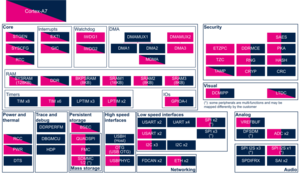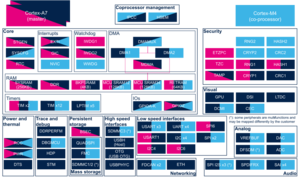deleted>Frq08988 mNo edit summary |
Registered User mNo edit summary |
||
| (21 intermediate revisions by 5 users not shown) | |||
| Line 1: | Line 1: | ||
<noinclude> | <noinclude>{{ApplicableFor | ||
{{ | |MPUs list=STM32MP13x, STM32MP15x | ||
|MPUs checklist=STM32MP13x,STM32MP15x | |||
}}</noinclude> | |||
</noinclude> | |||
==Article purpose== | ==Article purpose== | ||
The purpose of this article is to: | The purpose of this article is to: | ||
* briefly introduce the SAI peripheral and its main features | * briefly introduce the SAI peripheral and its main features | ||
* indicate the level of security supported by this hardware block | * indicate the level of security supported by this hardware block | ||
* explain how each instance can be allocated to the | * explain how each instance can be allocated to the runtime contexts and linked to the corresponding software components | ||
* explain how to configure the SAI peripheral. | * explain how to configure the SAI peripheral. | ||
| Line 18: | Line 14: | ||
===Features=== | ===Features=== | ||
Refer to [[STM32MP15 resources#Reference manuals|STM32MP15 reference manuals]] for the complete feature list, and to the software components, introduced below, to see which features are implemented.<br> | Refer to [[STM32MP13 resources#Reference manuals|STM32MP13 reference manuals]] or [[STM32MP15 resources#Reference manuals|STM32MP15 reference manuals]] for the complete feature list, and to the software components, introduced below, to see which features are implemented.<br> | ||
===Security support=== | ===Security support=== | ||
| Line 30: | Line 26: | ||
====Overview==== | ====Overview==== | ||
SAI instances can be allocated to: | SAI instances can be allocated to: | ||
* the Cortex-A7 non-secure for use in Linux with [[ALSA_overview|ALSA framework]] | * the Cortex-A7 non-secure for use in Linux with [[ALSA_overview|ALSA framework]] on {{MicroprocessorDevice | device=1}} | ||
* the Cortex-M4 for use in STM32Cube with [[STM32CubeMP1 architecture|STM32Cube SAI driver]] | * the Cortex-M4 for use in STM32Cube with [[STM32CubeMP1 architecture|STM32Cube SAI driver]] on {{MicroprocessorDevice | device=15}} only | ||
Chapter [[#Peripheral assignment]] exposes which instance can be assigned to which context. | Chapter [[#Peripheral assignment]] exposes which instance can be assigned to which context. | ||
====Software frameworks==== | ====Software frameworks==== | ||
{{: | ===== On {{MicroprocessorDevice | device=13}} ===== | ||
{{:STM32MP13 internal_peripherals_software_table_template}} | |||
| Audio | |||
| [[SAI internal peripheral|SAI]] | |||
| | |||
| [[ALSA_overview|ALSA framework]] | |||
| | |||
|- | |||
|} | |||
===== On {{MicroprocessorDevice | device=15}} ===== | |||
{{:STM32MP15_internal_peripherals_software_table_template}} | |||
| Audio | | Audio | ||
| [[SAI internal peripheral|SAI]] | | [[SAI internal peripheral|SAI]] | ||
| Line 49: | Line 55: | ||
The configuration is applied by the firmware running in the context to which the peripheral is assigned. The configuration can be done alone via the [[STM32CubeMX]] tool for all internal peripherals, then manually completed (particularly for external peripherals), according to the information given in the corresponding software framework article. | The configuration is applied by the firmware running in the context to which the peripheral is assigned. The configuration can be done alone via the [[STM32CubeMX]] tool for all internal peripherals, then manually completed (particularly for external peripherals), according to the information given in the corresponding software framework article. | ||
When the Arm<sup>®</sup> Cortex<sup>®</sup>-A7 core operates in non-secure access mode, the SAI is controlled by the Linux kernel framework. | When the Arm<sup>®</sup> Cortex<sup>®</sup>-A7 core operates in non-secure access mode, the SAI is controlled by the Linux kernel framework. | ||
Refer to [[SAI Linux driver]] to drive the SAI through Linux kernel [[ALSA_overview|ALSA framework]]. Refer to [[Soundcard configuration]] and [[SAI device tree configuration]] to configure the SAI through the Linux kernel device tree<ref>[[Device tree]]</ref>. | Refer to [[SAI Linux driver]] to drive the SAI through Linux kernel [[ALSA_overview|ALSA framework]]. Refer to [[Soundcard configuration]] and [[SAI device tree configuration]] to configure the SAI through the Linux kernel device tree<ref>[[Device tree]]</ref>. | ||
====Peripheral assignment==== | ====Peripheral assignment==== | ||
{{: | ===== On {{MicroprocessorDevice | device=13}} ===== | ||
< | {{:STM32MP13_internal_peripherals_assignment_table_template}} | ||
<section begin=stm32mp13 /> | |||
| rowspan="2" | Audio | |||
| rowspan="2" | [[SAI internal peripheral|SAI]] | |||
| SAI1 | |||
| | |||
| <span title="assignable peripheral" style="font-size:21px">☐</span> | |||
| Assignment (single choice) | |||
|- | |||
| SAI2 | |||
| | |||
| <span title="assignable peripheral" style="font-size:21px">☐</span> | |||
| Assignment (single choice) | |||
|- | |||
<section end=stm32mp13 /> | |||
|} | |||
===== On {{MicroprocessorDevice | device=15}} ===== | |||
{{:STM32MP15_internal_peripherals_assignment_table_template}} | |||
<section begin=stm32mp15 /> | |||
| rowspan="4" | Audio | | rowspan="4" | Audio | ||
| rowspan="4" | [[SAI internal peripheral|SAI]] | | rowspan="4" | [[SAI internal peripheral|SAI]] | ||
| Line 85: | Line 105: | ||
| Assignment (single choice) | | Assignment (single choice) | ||
|- | |- | ||
</ | <section end=stm32mp15 /> | ||
|} | |} | ||
==How to go further== | ==How to go further== | ||
STM32H7 SAI training <ref> [https://www.st.com/content/ccc/resource/training/technical/product_training/group0/d3/c0/b0/0e/fe/eb/40/a9/STM32H7-Peripheral-Serial-Audio-Interface_SAI/files/STM32H7-Peripheral-Serial-Audio-Interface_SAI.pdf/_jcr_content/translations/en.STM32H7-Peripheral-Serial-Audio-Interface_SAI.pdf STM32H7 SAI training]</ref> introduces the SAI features and applications. The SAI versions in STM32H7 and {{MicroprocessorDevice | device=1}} are very close. In consequence this training is also relevant for {{MicroprocessorDevice | device=1}}. The user should refer to the [[STM32MP13 resources#Reference manuals|STM32MP13 reference manuals]] or [[STM32MP15 resources#Reference manuals|STM32MP15 reference manuals]] for a complete description. | |||
==References== | ==References== | ||
<references/> | <references/> | ||
<noinclude> | |||
{{ArticleBasedOnModel | Internal peripheral article model}} | |||
{{PublicationRequestId | 8893 | 2018-10-17 | PhilipS}} | |||
[[Category:Audio peripherals]] | |||
</noinclude> | |||
Latest revision as of 15:40, 1 February 2022
1. Article purpose[edit source]
The purpose of this article is to:
- briefly introduce the SAI peripheral and its main features
- indicate the level of security supported by this hardware block
- explain how each instance can be allocated to the runtime contexts and linked to the corresponding software components
- explain how to configure the SAI peripheral.
2. Peripheral overview[edit source]
The SAI (Serial Audio Interface) offers a wide set of audio protocols, such as: I2S standards (LSB or MSB-justified), PCM/DSP, TDM and S/PDIF. The SAI contains two independent audio sub-blocks. Each sub-block has its own clock generator and I/O line controller, and can be configured either as transmitter or receiver.
2.1. Features[edit source]
Refer to STM32MP13 reference manuals or STM32MP15 reference manuals for the complete feature list, and to the software components, introduced below, to see which features are implemented.
2.2. Security support[edit source]
All the SAI instances are non secure peripherals.
3. Peripheral usage and associated software[edit source]
3.1. Boot time[edit source]
The SAI is not used at boot time.
3.2. Runtime[edit source]
3.2.1. Overview[edit source]
SAI instances can be allocated to:
- the Cortex-A7 non-secure for use in Linux with ALSA framework on STM32MP1 Series
- the Cortex-M4 for use in STM32Cube with STM32Cube SAI driver on STM32MP15x lines
 only
only
Chapter #Peripheral assignment exposes which instance can be assigned to which context.
3.2.2. Software frameworks[edit source]
3.2.2.1. On STM32MP13x lines  [edit source]
[edit source]
| Domain | Peripheral | Software components | Comment | |
|---|---|---|---|---|
| OP-TEE | Linux | |||
| Audio | SAI | ALSA framework | ||
3.2.2.2. On STM32MP15x lines  [edit source]
[edit source]
| Domain | Peripheral | Software components | Comment | ||
|---|---|---|---|---|---|
| OP-TEE | Linux | STM32Cube | |||
| Audio | SAI | ALSA framework | STM32Cube SAI driver | ||
3.2.3. Peripheral configuration[edit source]
The configuration is applied by the firmware running in the context to which the peripheral is assigned. The configuration can be done alone via the STM32CubeMX tool for all internal peripherals, then manually completed (particularly for external peripherals), according to the information given in the corresponding software framework article.
When the Arm® Cortex®-A7 core operates in non-secure access mode, the SAI is controlled by the Linux kernel framework. Refer to SAI Linux driver to drive the SAI through Linux kernel ALSA framework. Refer to Soundcard configuration and SAI device tree configuration to configure the SAI through the Linux kernel device tree[1].
3.2.4. Peripheral assignment[edit source]
3.2.4.1. On STM32MP13x lines  [edit source]
[edit source]
Click on the right to expand the legend...
| Domain | Peripheral | Runtime allocation | Comment | ||
|---|---|---|---|---|---|
| Instance | Cortex-A7 secure (OP-TEE) |
Cortex-A7 non-secure (Linux) | |||
| Audio | SAI | SAI1 | ☐ | Assignment (single choice) | |
| SAI2 | ☐ | Assignment (single choice) | |||
3.2.4.2. On STM32MP15x lines  [edit source]
[edit source]
Click on the right to expand the legend...
| Domain | Peripheral | Runtime allocation | Comment | |||
|---|---|---|---|---|---|---|
| Instance | Cortex-A7 secure (OP-TEE) |
Cortex-A7 non-secure (Linux) |
Cortex-M4 (STM32Cube) | |||
| Audio | SAI | SAI1 | ☐ | ☐ | Assignment (single choice) | |
| SAI2 | ☐ | ☐ | Assignment (single choice) | |||
| SAI3 | ☐ | ☐ | Assignment (single choice) | |||
| SAI4 | ☐ | ☐ | Assignment (single choice) | |||
4. How to go further[edit source]
STM32H7 SAI training [2] introduces the SAI features and applications. The SAI versions in STM32H7 and STM32MP1 Series are very close. In consequence this training is also relevant for STM32MP1 Series. The user should refer to the STM32MP13 reference manuals or STM32MP15 reference manuals for a complete description.
5. References[edit source]

